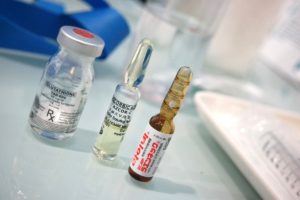
In response to the most recent revision for USP <1660> Evaluation of the Inner Surface Durability of Glass Containers, SGS has taken the lead in optimizing, validating and supporting the newest recommendations of applying the ICP impurities testing portion of the standard to meet current guidelines.
What’s the big deal?
The presence of glass flakes in a solution is a strong indication of the interaction between the drug product and the inside surface of the glass container. Delamination is defined as the separation of thin, sharp flakes of glass particles from the interior of a glass container. This occurrence is responsible for numerous pharmaceutical product recalls (like this) and is a serious issue when it comes to quality.
Many factors influence the durability of a glass container. These include: the composition of the glass, the coating of the surface, the temperatures at which annealing is performed, storage conditions of the glass, the drug substance inside the container and the shelf life of the drug itself.
In the past, one of the best ways to test for delamination was through the use of SEM. Scanning Electron Microscopes allows the user to view & confirm the presence of glass flakes within a liquid, proving delamination has occurred. However, this method is a reactive analysis that can only be confirmed once the flakes have broken off the container and are freely suspended in the solution.
In the recently updated USP <1660>, the chapter highlights a more proactive approach to ensure compliance with cGMP practices. It is recommended for drug manufacturing companies to perform stability studies and glass delamination testing.
How does CSL test for this?
One of the most critical evaluations of determining the suitability of a given glass container for a specific product is the potential increase of silicon dioxide concentration in the drug product over normal stability or when subjected to accelerated conditions. The formulation of a silica-rich layer poorly bonded to the substrate is the first stage of an extended delamination. Glass-liquid interactions are responsible for the formation of an altered later, which leads to swelling and cracking and the release of glass within the substance. This portion of the overall testing evaluation combined with the additional recommended testing methods, provides valuable information of the potential of a drug product to cause formation of glass particles and delamination of the inner glass surface.
CSL uses robust methods to accurately determine the concentration of Silicon in drug product or other appropriate matrices. These methods satisfy the requirements of USP <1660> ICP-MS testing and provide the critical information needed for product development and non-conformance investigations.
The Bottom Line
The responsibility to ensure the safety and integrity of a product in a glass container is placed solely on the drug product manufacturer, not the vial manufacturer. Because each matrix will react differently over time and in differing conditions, it’s important to understand the significance of the mechanism that’s occurring within the vial. Whether you are proactively testing to determine if a vial is compatible with your product, or reactively responding to an FDA non-conformance letter, SGS will help you assess your drug product.
For testing your product, please contact Chemical Solutions either by calling us at (717) 697 –7536 or submitting a request. Either way, we’ll respond promptly to your inquiry.



